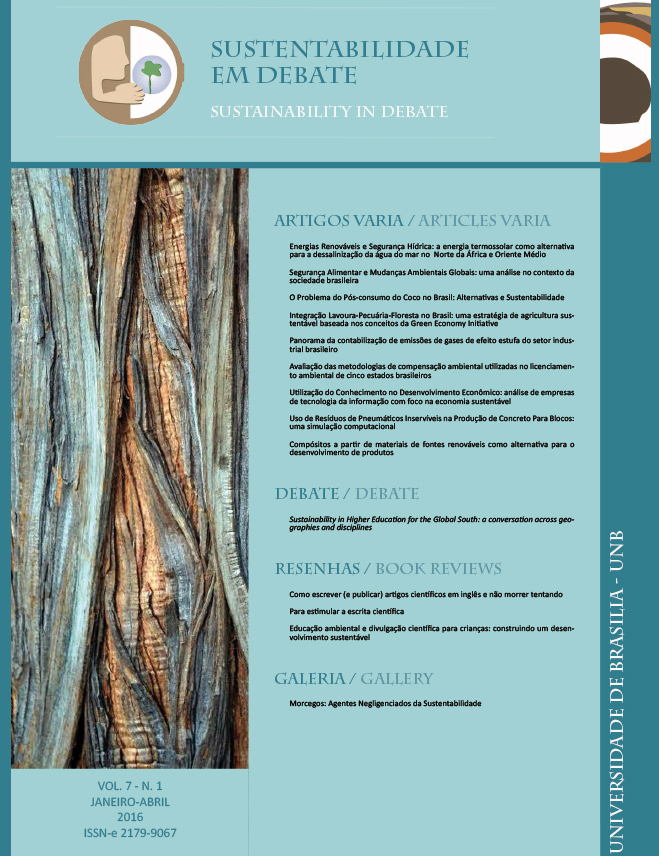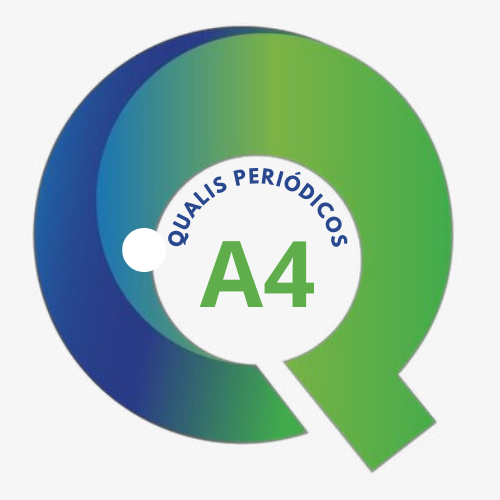Energias Renováveis e Segurança Hídrica:
a energia termossolar como alternativa para a dessalinização da água do mar no Norte da África e Oriente Médio
DOI :
https://doi.org/10.18472/SustDeb.v7n1.2016.15660Mots-clés :
Segurança Hídrica, Mudanças Climáticas, Dessalinização, Tecnologia CSP, Eficiência AlocativaRésumé
Os fenômenos associados à s mudanças climáticas, com os prognósticos de crescimento econômico e aumento populacional, tendem a agravar a escassez de água que afeta a quase totalidade dos países do Norte da África e do Oriente Médio. Com base em uma análise crítica do relatório “ACQUA-CSP”, discutiremos as iniciativas destinadas a mitigar o estresse hídrico nessas regiões, com especial ênfase para os processos de dessalinização da água do mar. O argumento principal consistirá em apontar o uso da energia termossolar enquanto estratégia sustentável para o aumento do fornecimento de água, uma vez que as usinas de dessalinização atualmente operantes funcionam com base no uso de combustíveis fósseis. A conclusão salientará que para uma gestão exitosa dos recursos hídricos, as soluções de engenharia e infraestrutura devem ser orientadas por instituições democráticas capazes de mediar os conflitos pela alocação dos recursos hídricos.
Téléchargements
Références
ÇARKOGLU, A.; EDER, M. Domestic Concerns and the Water Conflict over the Euphrates-Tigris River Basin. Middle Eastern Studies, v. 37, p. 41-71, 2001.
CENTRE FOR ENVIRONMENT AND DEVELOPMENT FOR THE ARAB REGION AND EUROPE. Water Conflicts and Conflict Management Mechanisms in the Middle East and North Africa Region. CEDARE, 2006.
COOK, C.; BAKKER, K. Water security: Debating an emerging paradigm. Global Environmental Changes, v. 22, p. 94-102, 2012.
DAMERAU, K. et al. Costs of reducing water use of concentrating solar power to sustainable levels: Scenarios for North Africa. Energy Policy, v. 39: p. 4391-98, 2011.
DEUTSCHES ZENTRUM FÜR LUFT ”“ UND RAUMFAHRT/DLR. Concentrating Solar Power for Seawater Desalination (AQUA-CSP). Stuttgart: Bundesministerium für Umwelt, Naturschutz und Reaktorsicherheit, 2007.
DEUTSCHES ZENTRUM FÜR LUFT ”“ UND RAUMFAHRT/DLR. Concentrating Solar Power for the Mediterranean Region (MED-CSP). Stuttgart: Bundesministerium für Umwelt, Naturschutz und Reaktorsicherheit, 2005.
DROOGERS, P. et al. Water resources trends in Middle East and North Africa towards 2050. Hydrology and Earth System Sciences, v. 16, p. 1-14, 2012.
ELIMELECH, M.; PHILLIP, W. The future of seawater desalination: Energy, technology and the environment. Science, v. 333, p. 712-17, 2011.
FOOD AND AGRICULTURE ORGANIZATION OF THE UNITED NATIONS/FAO. Review of World Water Resources by Country. FAO, 2003.
GLEICK, P. Water in Crisis: a Guide to the World's Fresh Water Resources. New York: Oxford University Press, 1993.
GLEICK, P. Water, War and Peace in the Middle East. Environment, v. 36, p. 6-42, 1994.
HABERMAS, J. Technik und Wissenschaft als “Ideologie”. Frankfurt am Main: Suhrkamp Verlag, 1969.
HARDIN, G. The Tragedy of the Commons. Science, New Series, v. 162, p. 1243-48, 1968.
HE, T.; YAN, L. Application of alternative energy integration technology in seawater desalination. Desalination, v. 249, p. 104-8, 2009.
INTERNATIONAL ENERGY AGENCY (IEA). Technology Roadmap: Concentrating Solar Power. Paris: OECD/IEA, 2010.
INTERGOVERNMENTAL PANEL ON CLIMATE CHANGE/IPCC. Climate Change 2007: Impacts, Adaptation and Vulnerability. Contribution of Working Group II to the Fourth Assessment Report of the International Panel on Climate Change. Cambridge: Cambridge University Press, 2007.
JOBSON, S. Water stressed regions: The Middle East and Southern Africa ”“ Global solutions. University of London, 1999.
KISER, S. Water: The Hydraulic parameter of conflict in Middle East and North Africa. Colorado: USAF Institute for National Security Studies, 2000.
LAMEI, A.; ZAAG, P.; MÜNCH, E. Impact of solar energy cost on water production cost of seawater desalination plants in Egypt. Energy Policy, v. 36, p. 1748-56, 2008.
LATTEMANN, S.; HÖPNER, T. Environmental impact and impact assessment of seawater desalination. Desalination, v. 220, p. 1-15, 2008.
LINDEMANN, J. H. Wind and solar powered seawater desalination. Applied solutions for the Mediterranean, Middle East and Gulf Countries. Desalination, v. 168, p. 73-80, 2004.
LONERGAN, S. Environment and society in the Middle East: conflicts over water, In: REDCLIFT, M.; WOODGATE, G. (org.). The International Handbook of Environmental Sociology. Cheltenham: Edward Elgar, 1997.
MEISEN, P. A Study of Very Large Solar Desert Systems with the Requirements and Benefits to those Nations Having High Solar irradiation Potential. San Diego: Global Energy Network Institute, 2006.
SADOFF, C.; MULLER, M. La gestión del agua, la seguridad hídrica y la adaptación al cambio climático: Efectos antecipados y respuestas esenciales. Global Water Partnership, n. 14, 2010.
SANDERS, R. Water desalting and the Middle East peace process. Technology in Society, v. 31, p. 94-9, 2008.
TRIEB, F. et al. Combined solar power and desalination plants for the Mediterranean region ”“ sustainable energy supply using large-scale solar thermal power plants. Desalination, v. 153, p. 39-46, 2002.
TRIEB, F.; NOKRASCHY, H. El. Concentrating Solar Power for Seawater Desalination. Alexandria: Twelfth International Water Technology Conference, 2008.
TRIEB, F. et al. Clean Power from Deserts: the Desertec Concept for Energy, Water and Clima Security (Whitebook). Bonn: Protext Verlag, 2009.
UNITED NATIONS/UN. World Population Prospects ”“ The 2012 Revision, Volume I: Commprehensive Tables. New York: Department of Economic and Social Affairs, 2013.
VAN BEEK, E.; ARRIENS, W. L. Water security: Putting the concept into practice. Global Water Partnership, n. 20, 2014.
WOLF, A. T. Hydropolitics along the Jordan River: Scarce water and its impact on the Arab-Israeli conflict. Tokyo: United Nations University Press, 1995.
WORLD BANK/WB. Renewable Energy Desalination: An Emerging Solution to Close the Water Gap in the Middle East and North Africa.Washington D. C.: World Bank, 2012.
Téléchargements
Publié-e
Comment citer
Numéro
Rubrique
Licence
SUSTAINABILITY IN DEBATE – Copyright Statement
The submission of original scientific work(s) by the authors, as the copyright holders of the text(s) sent to the journal, under the terms of Law 9.610/98, implies in the concession of copyrights of printed and/or digital publication to the Sustainability in Debate Journal of the article(s) approved for publication purposes, in a single issue of the journal. Furthermore, approved scientific work(s) will be released without any charge, or any kind of copyright reimbursement, through the journal’s website, for reading, printing and/or downloading of the text file, from the date of acceptance for publication purposes. Therefore, the authors, when submitting the article (s) to the journal, and gratuitous assignment of copyrights related to the submitted scientific work, are fully aware that they will not be remunerated for the publication of the article(s) in the journal.
The Sustainability in Debate Journal is licensed under Creative Commons License – Non-Commercial-No-Derivation Attribution (Derivative Work Ban) 3.0 Brazil, aiming at dissemination of scientific knowledge, as indicated on the journal's website, which allows the text to be shared, and be recognized in regards to its authorship and original publication in this journal.
Authors are allowed to sign additional contracts separately, for non-exclusive distribution of the works published in the Sustainability in Debate Journal (for example, in a book chapter), provided that it is expressed the texts were originally published in this journal. Authors are allowed and encouraged to publish and distribute their text online, following publication in Sustainability in Debate (e.g. in institutional repositories or their personal pages). The authors expressly agree to the terms of this Copyright Statement, which will be applied following the submission and publishing by this journal.






